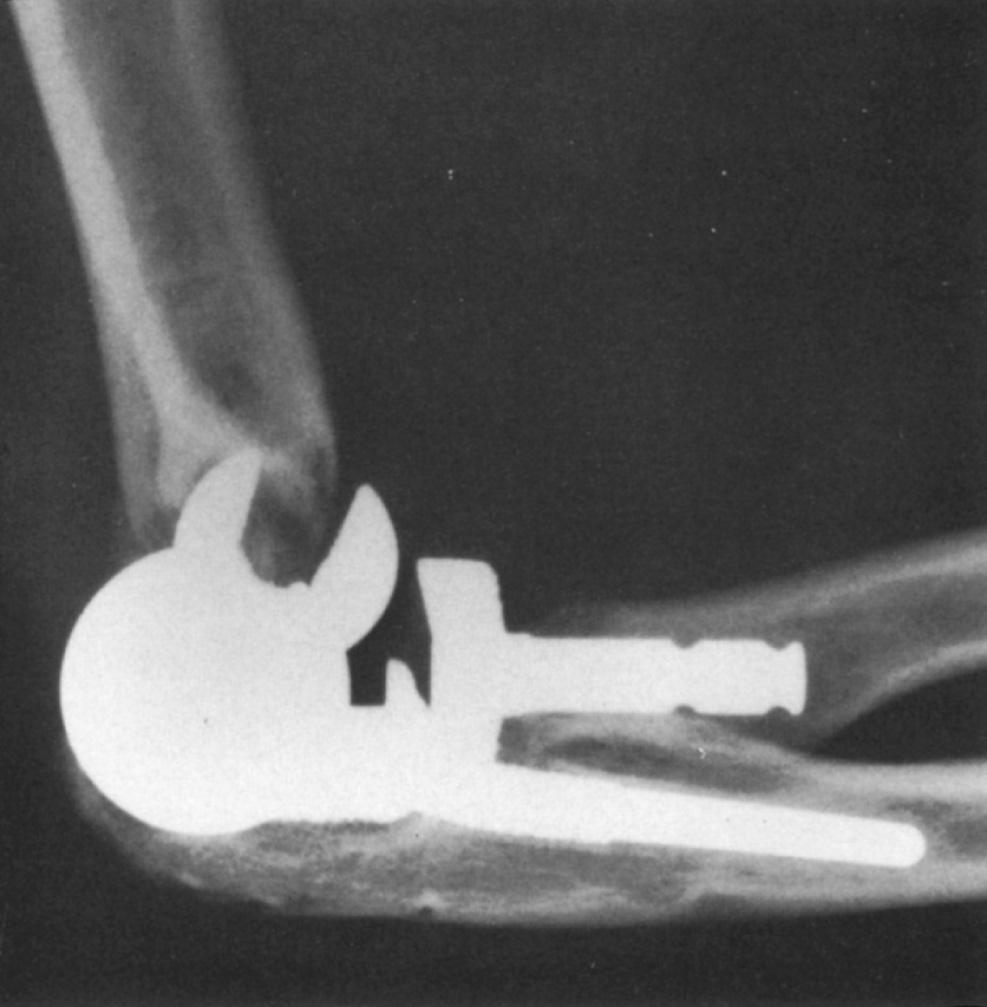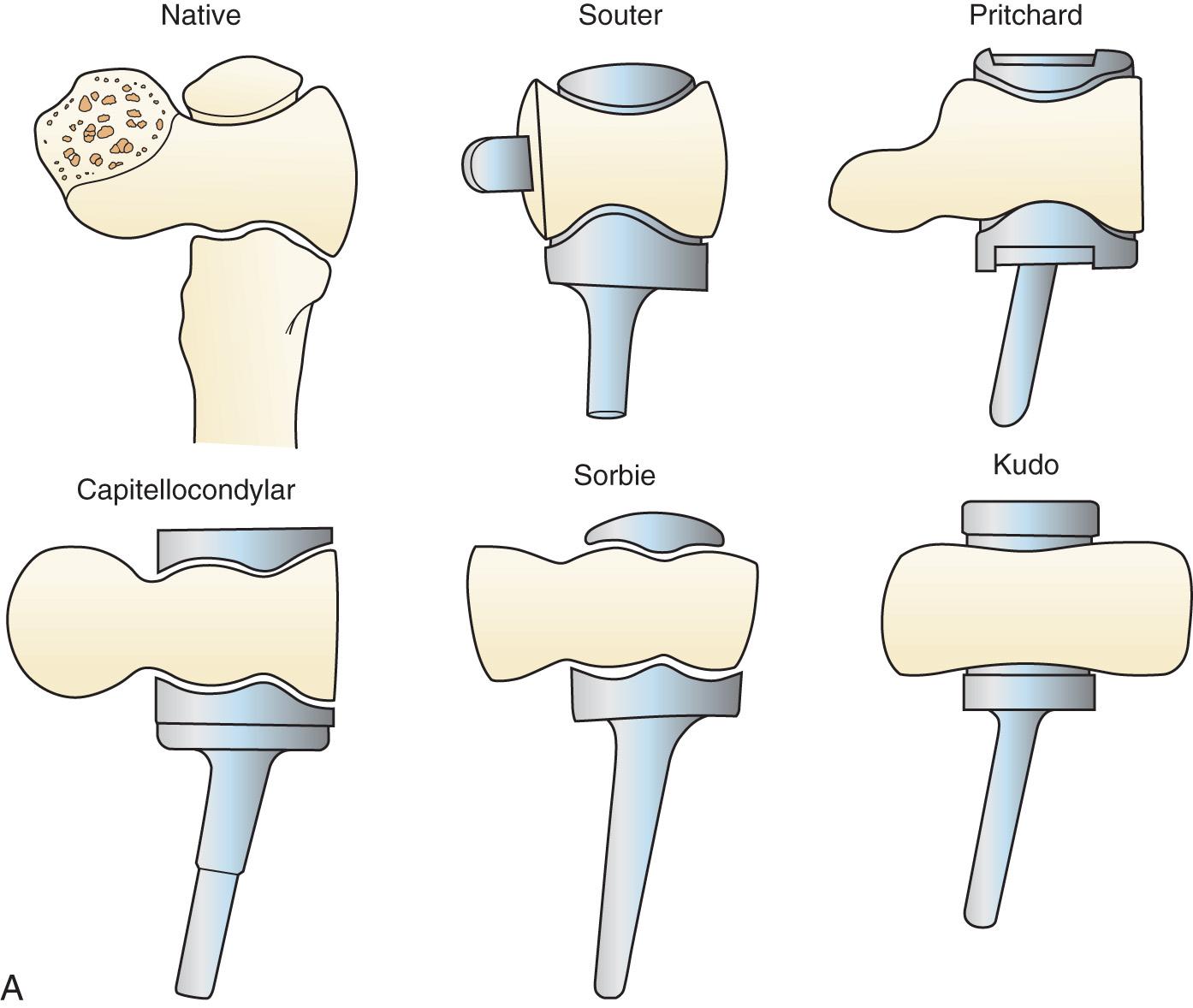Physical Address
304 North Cardinal St.
Dorchester Center, MA 02124
Total elbow arthroplasty (TEA) is indicated for pain and functional limitations secondary to inflammatory arthritis, osteoarthritis, posttraumatic arthritis, acute distal humeral fractures, distal humeral nonunions, tumors, osteonecrosis, and dysfunctional instability. Currently available prostheses can be subclassified as linked, unlinked, or convertible implants that can be interchanged between an unlinked or a linked design. This chapter will focus on the design considerations, techniques, and results of unlinked and convertible TEA.
Polyethylene wear and aseptic loosening of linked TEAs is a significant problem with longer follow-up, particularly in younger and more active patients. a
a References .
When a linked arthroplasty reaches the limits of its intrinsic laxity, forces are transmitted to the linkage mechanism and thereby to the stems and the bone implant interface, contributing to bearing wear and implant loosening. The concept of unlinked TEA is that there is a sharing of load between the prosthesis, capsule, ligaments, and muscles in an effort to decrease the stresses in the articulation and stems. A necessary prerequisite for an unlinked arthroplasty is the presence of adequate ligaments and bone stock with which the implant can be stabilized after insertion. Unlinked total elbows were initially referred to as resurfacing devices primarily because most were designed without a humeral stem. Due to the high incidence of implant loosening with these early designs, all unlinked prostheses that became widely used incorporated stems on the components in an effort to improve implant longevity ( Fig. 89.1 ). See Chapter 85 for the history of elbow arthroplasty.

Unlinked TEAs are sometimes referred to as unconstrained devices, whereas loose-hinge linked devices are often referred to as being semiconstrained; however, this is a misnomer. All joint arthroplasties have some element of intrinsic constraint by virtue of the shape and interaction of their articular surfaces. The intrinsic constraints of the ulnotrochlear joint of five unlinked TEA designs were compared and found to vary markedly among implant types. Surprisingly, the implants that more closely resembled the articular geometry of the native articulation tended to less accurately replicate the intrinsic constraint of the human elbow ( Fig. 89.2 ). In a series of cadaveric studies, the kinematics and stability of unlinked and convertible TEAs have been evaluated. b
b References .
The mechanical behavior of these prostheses has been found to vary markedly depending on their articular design. Linking an unlinked convertible total elbow has been shown to increase the stability as would be expected.

In an effort to improve their stability and load transfer, some unlinked designs have incorporated a radial head replacement. The radial head component has been shown to improve the stability of unlinked elbow prostheses in in vitro biomechanical studies. While theoretically improving soft tissue balance and load transfer across the elbow, the experience with radial head components in TEA has been variable ( Fig. 89.3 ). For example, the radial head component of the capitellocondylar prosthesis was abandoned due to concerns about radiolucent lines around the implant stem, but a subsequent study reported that the outcome was better if a radial head component was utilized. The Pritchard elbow resurfacing system (ERS) total elbow prosthesis was reported to have a higher failure rate if the radial head was not replaced, however, technical issues with positioning the radial head component were common. Preservation of the native radial head provided the longest functioning implants. One possible explanation of the variable results with radial head prostheses in unlinked implants to date may be that in many cases, their designs have been suboptimal. Furthermore, the addition of a third component complicates the surgical technique, making it more challenging to perform correctly, particularly since the instrumentation available to accurately position unlinked total elbows has been lacking relative to other joints such as the hip and knee. Incorrect positioning of a radial head component will result in eccentric motions during prosupination, and therefore shear forces across the radiocapitellar articulation. These abnormal kinematics and loads may cause polyethylene wear and early loosening of the radial component. A bipolar radial head component may be more forgiving in this setting as it will compensate for some of the eccentric motions through the bipolar articulation but may be prone to implant dissociation.

Functional and balanced collateral ligaments are a key feature of a successful unlinked TEA. Incompetent ligaments will result in articular maltracking, joint subluxation, or dislocation. This has been demonstrated in in vitro cadaveric studies and observed clinically. Maltracking of the arthroplasty will lead to excessive polyethylene wear, osteolysis, and aseptic loosening. During the insertion of most unlinked designs, one or both of the collateral ligaments are usually released to achieve adequate exposure. Careful repair and successful ligament healing are needed if an unlinked arthroplasty is to be stable and to articulate normally.
Optimal component positioning improves the outcome of an unlinked TEA. Replication of the axis of motion to the native state restores the muscle moment arms and the soft tissue tension of the collateral ligaments, which ensures more normal articular tracking and implant loading. Malpositioning of the humeral component has been demonstrated to alter the in vitro kinematics and stability of the capitellocondylar arthroplasty. It has also been reported that correct medial–lateral and proximal–distal positioning of the Souter implant lowered the incidence of loosening. Another study evaluating the same implant, however, was unable to demonstrate a relationship between humeral component position and aseptic loosening. Current techniques to identify and replicate the flexion–extension axis are prone to error. In one study, the surgeon's ability to select the flexion–extension axis resulted in errors in axis orientation of up to 10 degrees in normal humeri; these errors are likely greater in clinical practice where the anatomy is more distorted and the exposure of landmarks is compromised. Computer and/or image-assisted surgery has been shown to improve the accuracy of elbow component placement. However, this technology is currently not available for clinical use.
While many patients with elbow arthritis can be managed with an unlinked elbow arthroplasty, there are patients who require a linked prosthesis due to a lack of adequate bone stock or functional collateral ligaments. While typically this can be predicted preoperatively, it is always desirable to have a linkable implant immediately available in the operating room whenever a surgeon is planning to perform an unlinked TEA. Intraoperatively, if an unlinked implant is not stable or is not articulating congruously, then it should be converted to a linked design. If this is recognized before the unlinked components are cemented then a different design of linked arthroplasty can be used, although repeat bony preparation will be needed, which is time-consuming. The advantage of a convertible prosthesis is significant in this setting, as rather than changing prosthesis designs, a linkage mechanism can simply be applied to the same prosthesis for which the bony resection has been completed. If the stems have already been cemented then the ability to couple an unlinked prosthesis without removing the stems makes a convertible implant system even more appealing. The advantage of having one implant system to manage the majority of clinical situations is also helpful for hospitals by reducing inventories and cost. For surgeons, a convertible design means only one implant system needs to be mastered; the implant can be routinely used as a linked device, and in selected younger or more active patients with good bone stock and ligaments the device can be used in the unlinked configuration.
While most patients who undergo an unlinked TEA have an excellent outcome, there are some patients who develop elbow instability postoperatively, which is often difficult to manage as discussed in Chapter 105 . When instability is recognized early, a closed reduction and a period of immobilization may allow the ligaments to heal and the prosthesis to function normally. However, when presenting as a chronic problem, attempts at ligament reconstruction have not been reliable. The concept of having an unlinked elbow arthroplasty that can be linked in the setting of postoperative elbow instability is desirable, as removal of a well-fixed unlinked elbow arthroplasty with revision to a linked arthroplasty is technically difficult, with a significant risk of complications.
Hemiarthroplasty of the distal humerus is becoming more popular to manage comminuted articular fractures of the distal humerus, nonunions, and avascular necrosis as discussed in Chapter 88 . Should the patient develop instability, ulnar subsidence, or have persistent pain, the ability to convert a distal humeral hemiarthroplasty to either a linked or unlinked TEA without removing a well-fixed humeral component, is attractive.
By virtue of their need for adequate ligaments and bone stock, the indications for unlinked designs are narrower than linked arthroplasties and the instability rate is greater. While the loosening rate should theoretically be lower with unlinked versus linked prostheses, this has yet to be proven in clinical studies. With the advent of improved linked-elbow arthroplasty designs and a lack of compelling evidence to support the superior outcome of unlinked implants in the literature, the popularity of unlinked implants has decreased in recent years. Furthermore, with the development of improved biologic agents, the incidence of patients with rheumatoid arthritis requiring elbow replacements has decreased, which was the principal indication for an unlinked device in the past. Posttraumatic conditions and acute distal humeral fractures—disorders that usually require a linked device—are currently the most common indications for a TEA. As a result of these changing disease patterns and suboptimal long-term outcomes of many older unlinked designs, most are no longer commercially available.
The indications for an unlinked or convertible TEA are similar to those for any design of elbow arthroplasty. The necessary prerequisites to choose an unlinked implant or use the unlinked version of a convertible implant are the presence of sufficient bone stock to support the implant and intact medial and lateral collateral ligaments. The presence of functioning elbow flexor and extensor muscles is particularly important if the implant is to be unlinked, as muscle function is important for stability. In the absence of sufficient bone stock or ligaments, a linked arthroplasty or the linked version of a convertible arthroplasty should be used. Typical indications include inflammatory arthritis (rheumatoid, psoriatic, and hemophilic), primary or posttraumatic osteoarthritis, osteonecrosis, periarticular tumors, and comminuted distal humeral articular fractures in elderly patients.
Become a Clinical Tree membership for Full access and enjoy Unlimited articles
If you are a member. Log in here